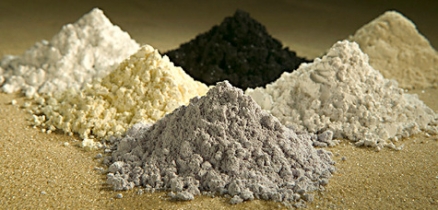China’s Rare Earth Industry
| Topics: |
Geology (main)
|
?Main Image: These rare-earth oxides are used as tracers to determine which parts of a watershed are eroding. Clockwise from top center: praseodymium, cerium, lanthanum, neodymium, samarium, and gadolinium. Source: Wikimedia Commons.
China’s rare-earth industry
China’s dominant position as the producer of over 95 percent of the world output of rare-earth minerals and rapid increases in the consumption of rare earths owing to the emergence of new energy and military-related technologies, combined with China’s decisions to restrict exports of rare earths, have resulted in heightened concerns about the future availability of rare earths. As a result, industrial countries such as Japan, the United States, and countries of the European Union face tighter supplies and higher prices for rare earths. This paper briefly reviews China’s rare-earth production, consumption, and reserves and the important policies and regulations regarding the production and trade of rare earths, including recently announced export quotas.
The 15 lanthanide elements—lanthanum, cerium, praseodymium, neodymium, promethium, samarium, europium, gadolinium, terbium, dysprosium, holmium, erbium, thulium, ytterbium, and lutetium (atomic numbers 57–71)—were originally known as the rare earths from their occurrence in oxides mixtures. Recently, some researchers have included two other elements—scandium and yttrium—in their discussion of rare earths. Yttrium (atomic number 39), which lies above lanthanum in transition group III of the periodic table and has a similar 3+ ion with a noble gas core, has both atomic and ionic radii similar in size to those of terbium and dysprosium and is generally found in nature with lanthanides. Scandium (atomic number 21) has a smaller ionic radius than yttrium and the lanthanides, and its chemical behavior is intermediate between that of aluminum and the lanthanides. It is found in nature with the lanthanides and yttrium.
Rare earths are used widely in high-technology and energy products because they impart special properties of magnetism, luminescence, and strength. Rare earths are also used in weapon systems to obtain the same properties.
Editor's Notes
- The Author is ptse@usgs.gov Pui-Kwan Tse, National Minerals Information Center, U.S. Geological Survey.
- Download the Full Report at the link to the right.
- Also, see: Rare Earths - Statistics and Information(cerium, dysprosium, erbium, europium, gadolinium, holmium, lanthanum, lutetium, neodymium, praseodymium, samarium, terbium, thulium, ytterbium, yttrium, ferrocerium, monazite, bastnasite, mischmetal).
